Detailed description, PPS
|
|
Detailed description, PPS
|
The PPS control module calculates the weight in the seat using an algorithm. The pressure sensor (642), which detects the pressure in the silicone filled seat mat, sends the measured value to the control module which converts the measured pressure into weight (kg). If the weight is:
|
•
|
less than or equal to 25.6 kg then information is sent to the ACM to disconnect the passenger airbag/side airbag.
|
|
•
|
greater than or equal to 46.7 kg then information is sent to the ACM to connect the passenger airbag/side airbag.
|
In accordance with a guideline value the weight of a 6 year-old is less than or equal to 25.6 kg. The guideline value for an adult is equivalent to a woman weighing 46.7 kg or more.
There is a nominal value between these weights which is based on the calibrated weight. There are two nominal values: one for each seat, 9-3 4D/5D and 9-3 CV.
Apart from the nominal value the control module takes into consideration the tensioning force of the seatbelt as well as the internal and external temperatures.
The belt force sensor, which is located on the anchorage point of the belt, provides the control module with information on tensioning force and determines whether there is a seated person or attached child seat which could affect the weight in the seat. In this way the PPS control module can calculate the correct weight and send information to the airbag control module which in turn connects or disconnects the passenger airbag and side airbag. The PPS control module illuminates the indicator lamps in the SIDC.
A serial communication cable is connected between PPS and the airbag control module. The PPS control module transmits messages on:
|
•
|
Passenger airbag/Side airbag ON/OFF
|
|
•
|
Passenger sitting in seat YES/NO (sends information to the ACM, seatbelt reminder)
|
Airbag control module transmits messages on:
In the event of a fault in the Passenger Presence System the passenger airbag/side airbag is switched off.
There are four statistical algorithm functions.
|
|
•
|
A fixed upper or lower limit in order to establish the nominal threshold value.
|
|
|
•
|
Adjustment of nominal threshold level when an adult is belted in the passenger seat during driving.
|
|
|
•
|
Adjustment of nominal threshold level when a child is belted in the passenger seat during driving.
|
|
2.
|
Adjusting algorithm based on passenger seat ageing. This takes place when the seat is empty.
|
|
|
•
|
Adjustment of seat weight.
|
|
|
•
|
Nominal threshold value is adjusted either up or down.
|
|
3.
|
Adjusting algorithm based on passenger seat environment.
|
|
|
•
|
Temperature compensation using sensor built into PPS.
|
|
|
•
|
Calibration of pressure.
|
|
4.
|
Adjusting algorithm based on belt force sensor (643)
|
|
|
•
|
Compensation of tensioning force.
|
Explanation
Adult limit value is equivalent to a woman who weighs 46.7 kg or more. Child limit value is equivalent to a 6 year-old who weighs less than or equal to 25.6 kg. The threshold value for the seat is a reference value of a load. Each car model has its own reference value. This value is programmed by Saab. Nominal threshold value for the seat is a value based on the seat threshold value which then adapts to the weight in the seat.

|
Adaptive calculation algorithms
|
There are also two adaptive calculation algorithms which take account not only of whether a child or an adult is sitting in the seat but also the ageing characteristics of the system and the seat.
1a. Programming during driving for adult or child:
|
•
|
adjustment of the algorithmical calculation takes place in small steps
|
|
•
|
a smooth adaptation that is adapted to a passenger sitting still
|
Conditions for programming the algorithm, adults or children
|
•
|
if the pressure (weight) is above or below the nominal value for 2.5 minutes then the threshold value will be adjusted
|
|
•
|
the threshold value can be adjusted in a maximum of 5 steps
|
|
•
|
each step takes place after 2.5 minutes
|
Example, adult
: If the passenger's weight is above the threshold value for the seat but under the adult limit value of 46.7 kg then the nominal threshold value for the seat will drop by 5 steps, one step each 2.5 minutes, (one step ~ 0.5kg)
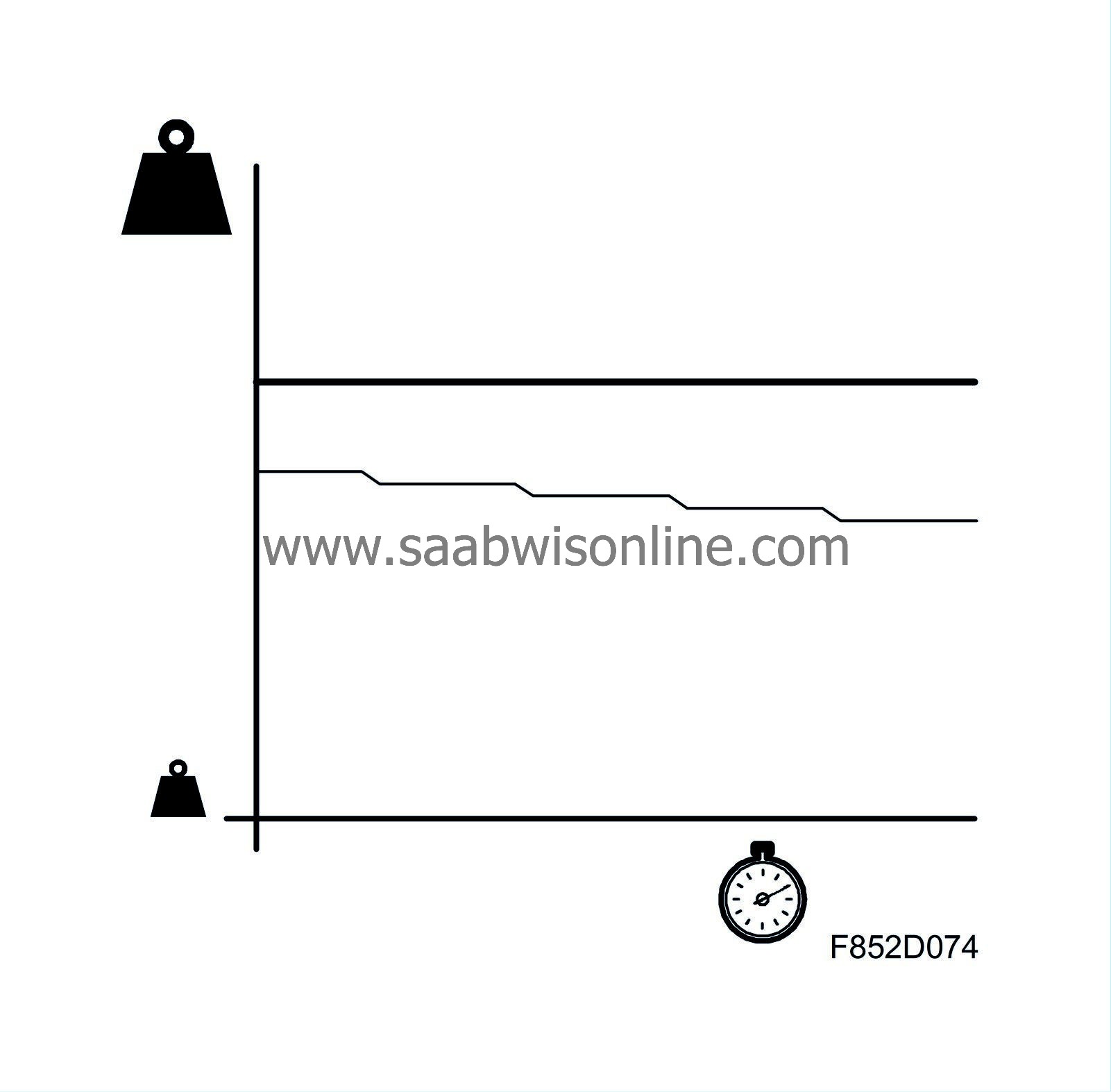
Example, child
: If the passenger's weight is under the threshold value for the seat but over 25.6 kg which is the permitted limit value for a child then the nominal threshold value for the seat will rise by 5 steps. One step each 2.5 minutes, (one step ~ 0.5kg)

1b. Programming (adult or child)
|
•
|
a rapid adaptation that adjusts to sudden movements by the passenger in the seat
|
|
•
|
the algorithm changes the nominal threshold value up or down by ~ 0.7 kg
|
Conditions for programming the algorithm for adults or children
|
•
|
The pressure is over or under the nominal threshold value or outside of the tolerances for a minute. The nominal threshold value will be adjusted ~ 0.7 kg
|
|
•
|
The temperature must be within the tolerance range.
|
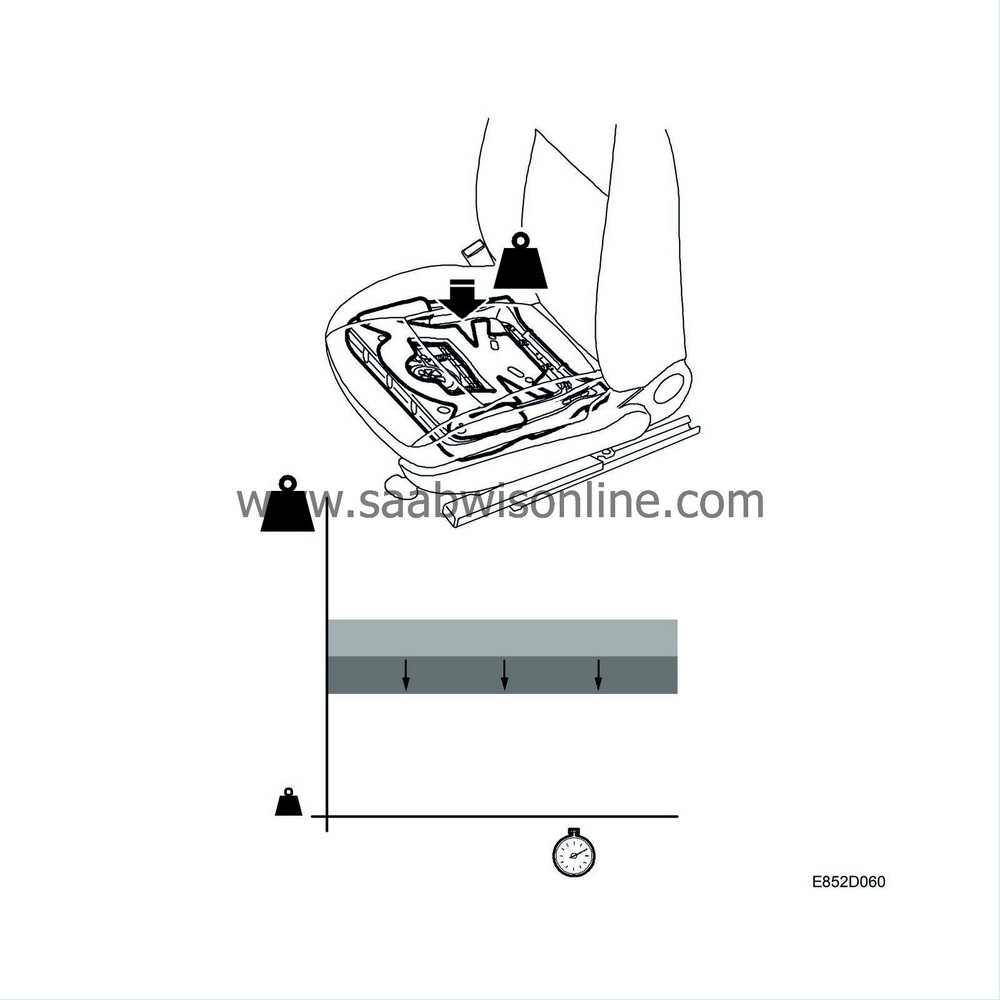 If the passenger weighs ~20% or more than the threshold value for the seat and under the permitted threshold value for adults for more than 1 minute then the nominal threshold value for the seat will be reduced by ~ 0.7 kg. Low limit value, adult.
If the passenger weighs ~20% or more than the threshold value for the seat and under the permitted threshold value for adults for more than 1 minute then the nominal threshold value for the seat will be reduced by ~ 0.7 kg. Low limit value, adult.
If the weight of the passenger is below ~15% or more of the threshold value of the seat and above 9 kg of what is the minimum permitted limit value for a child then the nominal permitted threshold value will rise by ~0.7 kg.
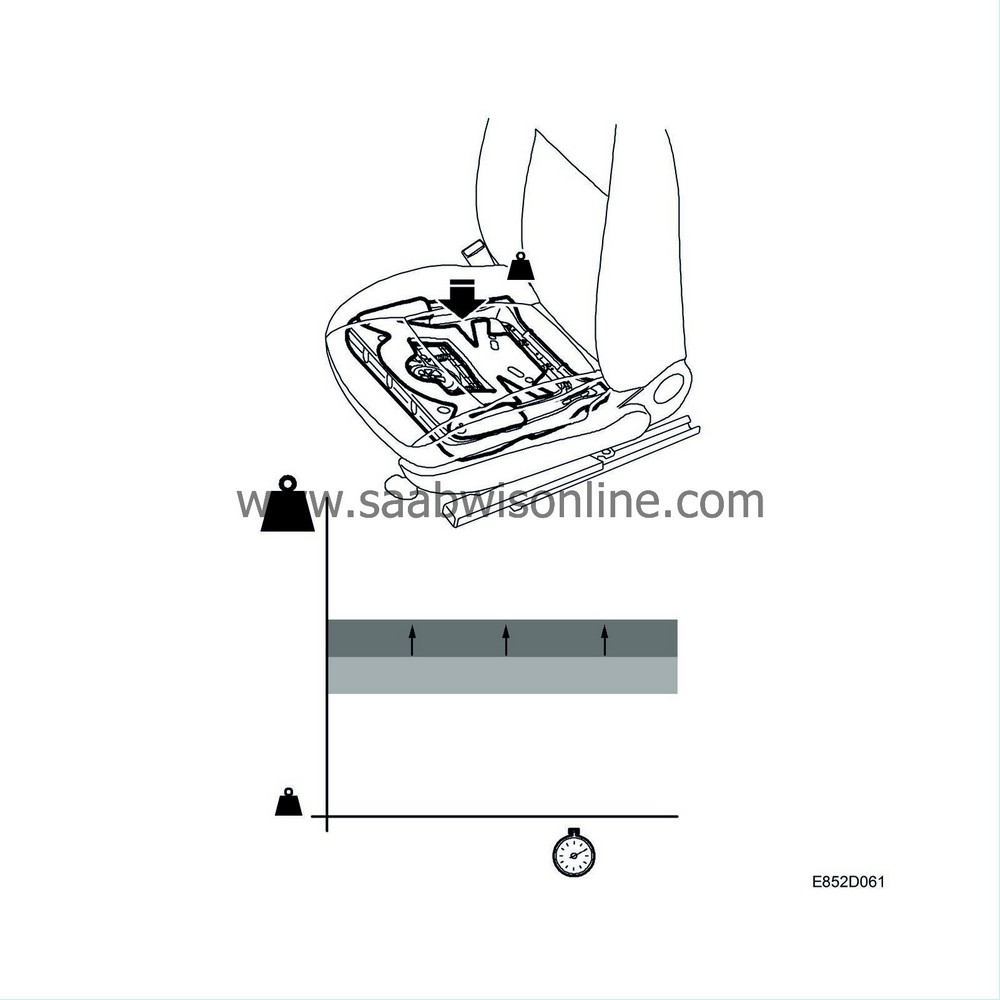
2.a Programming empty passenger seat (Learn down)
|
•
|
Permits the system to compensate for the value of the tensioning force. The seat cushion and upholstery lose their tension during their service life.
|
Conditions (Learn down)

|
•
|
No passenger in the seat when the ignition is on
|
|
•
|
Low threshold value empty seat for 2 minutes (calibration)
|
|
•
|
Outside tolerance value (during calibration).
|
|
•
|
Temperature within values -40°C - 105°C (during calibration).
|
|
•
|
Program in one step every other time the ignition is switched on (during calibration) (one step is approx. 0.5 kg).
|
2b. Programming empty passenger seat (Learn up)
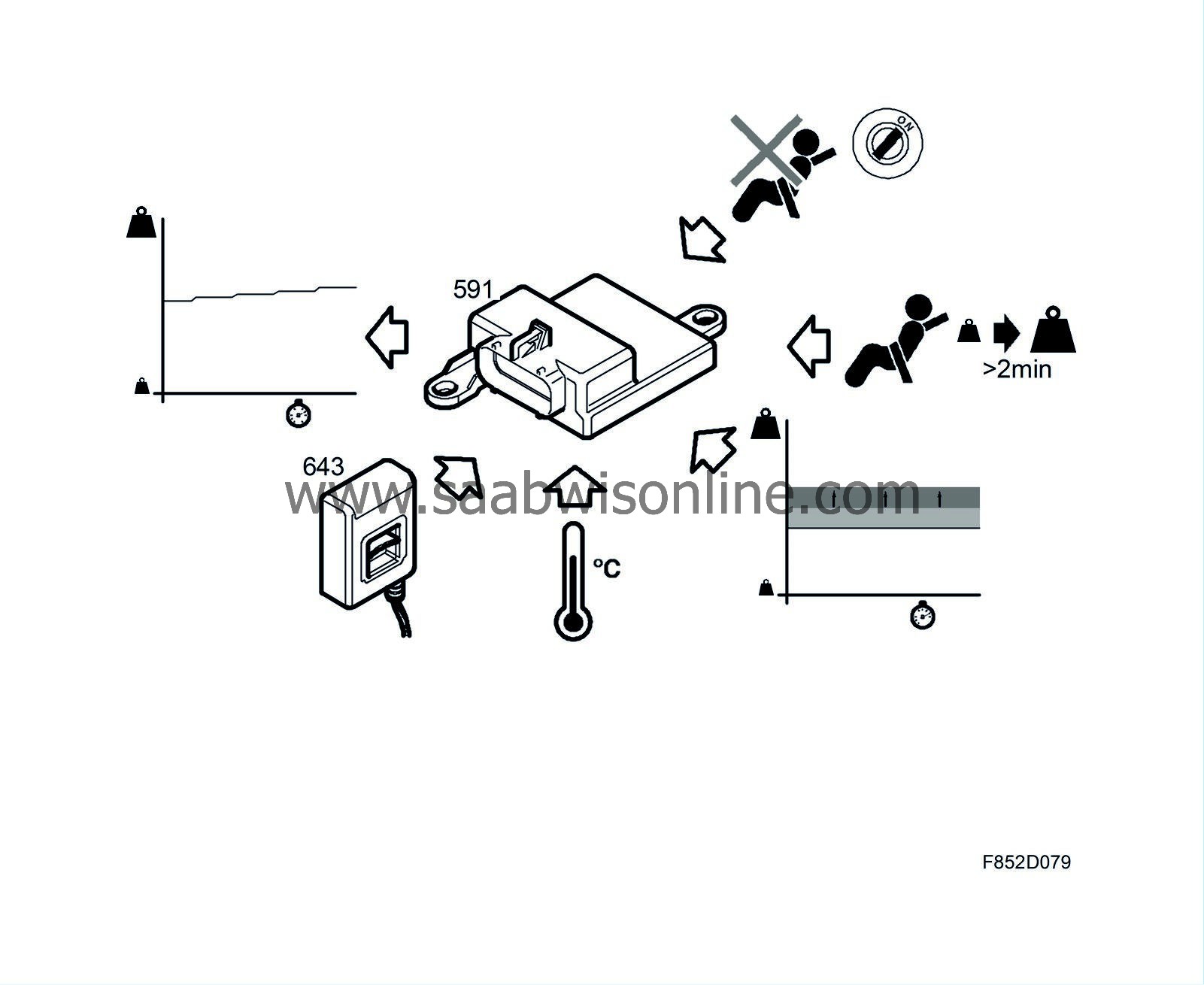 Permits the system to compensate for the value of the tensioning force. In the event of upholstery replacement or incorrect "Learn down".
Permits the system to compensate for the value of the tensioning force. In the event of upholstery replacement or incorrect "Learn down".
Conditions (Learn up)
|
•
|
No passenger in the seat when the ignition is on.
|
|
•
|
High threshold value empty seat for 2 minutes (during calibration).
|
|
•
|
Outside tolerance value (during calibration).
|
|
•
|
Temperature within values -40°C - 105°C (during calibration)
|
|
•
|
Program one step every time the ignition is switched on (during calibration) (one step is approx. 0.5 kg).
|
|
•
|
The belt force sensor is under the value, not tensioned.
|
|
Control module, PPS (Passenger Presence System) (591)
|
The PPS control module which is calibrated with the seat from Saab includes, depending on model amongst other things: seat foam, silicone bladder, spring mat and heating pad.
Using an algorithm, the PPS control module then calculates the weight in the seat. The PPS control module detects the pressure in the silicone filled seat mat. The measured pressure is converted into kg.
If the weight is:
|
•
|
< or equal to 25.6 kg information is sent to the ACM to switch off the passenger airbag/side airbag
|
|
•
|
> or equal to 46.7 kg information is sent to the ACM to switch on the passenger airbag/side airbag
|
In accordance with a guideline value the weight of a 6 year-old is less than or equal to 25.6 kg. The guideline value for an adult is equivalent to a woman weighing 46.7 kg or more.
Illustration of the zone between the weights.
Using the belt force sensor the PPS control module can detect the tensioning force in the belt and determine whether there is a seated person or attached child seat which could affect the weight in the seat. In this way the PPS control module can calculate the correct weight and send the information to the airbag control module.
The PPS control module illuminates the indicator lamp in the SIDC.
A serial communication cable is connected between PPS and the airbag control module. The PPS control module transmits messages on:
|
•
|
Passenger airbag/Side airbag ON/OFF
|
|
•
|
Passenger sitting in seat YES/NO (sends information to the ACM, seatbelt reminder)
|
Airbag control module transmits messages on:
In the event of a fault in the Passenger Presence System the passenger airbag and side airbag are disconnected and the indicator lamp "Passenger Airbag OFF" is illuminated.
|
Pressure sensor, loaded seat cushion, front passenger (642)
|
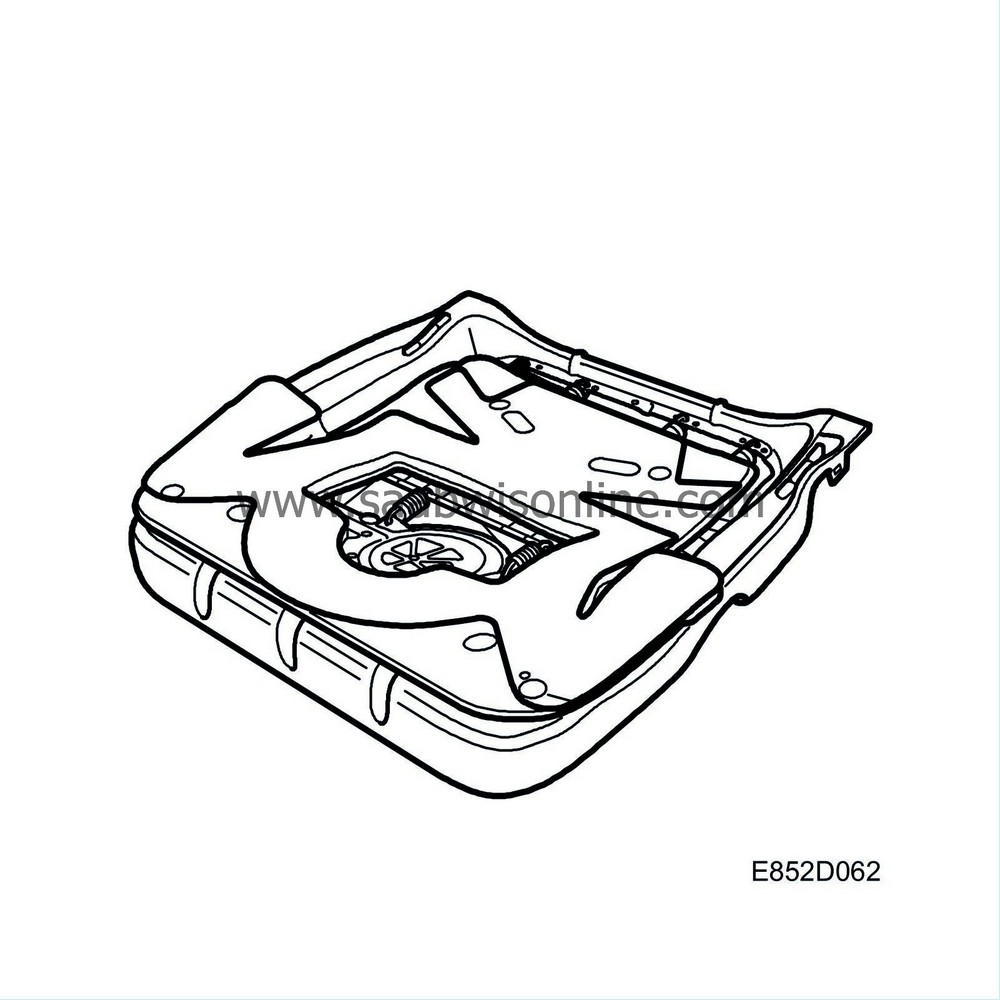
On the passenger side there is a silicone filled seat mat with a pressure sensor. The silicone in the plastic mat forms a pressure that is measured via a pressure sensor (642) by the control module (591). The silicone seat mat is calibrated together with the seat cushion assembly and the PPS control module on delivery from Saab.
|
Force sensor, seatbelt, front passenger (643)
|
On the belt tensioner on the belt's lower anchorage point, there is a force sensor, which detects the loading on the seat belt. This is a hall sensor type whose function is to supply the control module (591) with information on tensioning force when the child seat is tensioned. The signal value is between 0-5 volts. Using this parameter the control module (591) calculates the actual weight in the seat.
Example: if the tensioning force is great then the weight in the passenger seat is affected. The measured weight that is calculated in the PPS control module must be reduced and filtered.
|
Indicator lamp, Passenger Airbag ON/OFF (612a/b)
|
When the ignition key is turned to the start or drive position the indicator LEDs for passenger airbag ON/OFF are illuminated for 5-6 seconds with maximum light intensity for a lamp check. Following which, either the ON or the OFF LED will be illuminated.
The ON or the OFF indicator lamp follows the lighting level in the instrument in four steps.
The rheostat values are:
In the event of a fault in the PPS system the airbag lamp will illuminate together with the "Passenger airbag OFF" indicator lamp.











